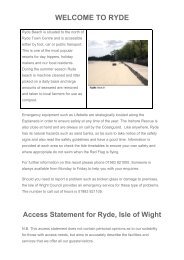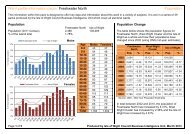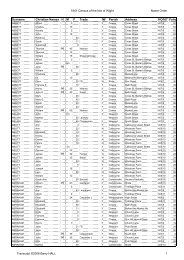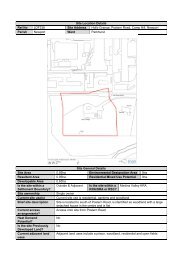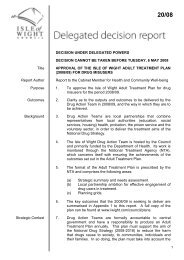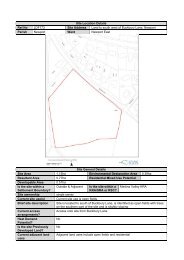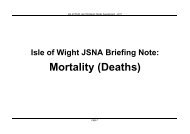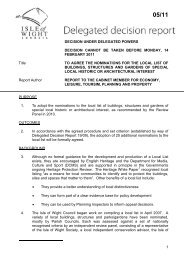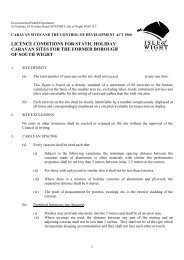Thorley Wellow Plain HEAP - Isle of Wight Council
Thorley Wellow Plain HEAP - Isle of Wight Council
Thorley Wellow Plain HEAP - Isle of Wight Council
- No tags were found...
Create successful ePaper yourself
Turn your PDF publications into a flip-book with our unique Google optimized e-Paper software.
o The boundary between <strong>Wellow</strong>’s open-field and <strong>Wellow</strong> Common is defined in themodern landscape by footpath S34.o The present-day ‘Hamstead Trail’ defines the eastern edge <strong>of</strong> <strong>Wellow</strong> Common.o The southern boundary <strong>of</strong> <strong>Wellow</strong> Common ran along the B3399.• Regular fields with a north-south axis between the chalk ridge and the B3399 wereprobably enclosed from downland-edge common in the 17 th or 18 th century.• Tapnell Farm is first mentioned as Tapwell Farm in 1715 and appears to be a postmedievalholding associated with the reclamation <strong>of</strong> rough ground, possibly including thelower slope <strong>of</strong> Tapnell Down but also land in the area <strong>of</strong> the present Tapnell Furze forestryplantation.o Tapnell Furze appears to have been a mosaic <strong>of</strong> wet and dry rough grazing land andscrub until reclamation took place and may have been the site <strong>of</strong> <strong>Thorley</strong>’s medievalrabbit warren (see above).o Dog Kennel Cottage, on the west side <strong>of</strong> Broad Lane, is <strong>of</strong> 18 th century date and mayhave been built as a squatter’s cottage on the edge <strong>of</strong> Tapnell Furze.o By 1793 Tapnell Furze had been enclosed into fairly large irregular fields (mainly usedfor grazing) but much <strong>of</strong> it is shown as rough ground on the 1866 6 inch OS map.• East Afton Farm (within Freshwater Parish) is not shown on the OS 1793 map although asmall unnamed building is shown nearby. The farm is first named and shown in its presentposition on the Freshwater Tithe Map <strong>of</strong> 1839.o This new farmstead may have been responsible for the enclosure <strong>of</strong> land to the north <strong>of</strong>the farmstead, including a large close named ‘North Park’ on the tithe map.o North Park, including the tiny area <strong>of</strong> surviving ancient woodland at North Park Copse,may have been the site <strong>of</strong> the medieval rabbit warren at Afton Manor mentioned in 1343(Margham 1992, 112-113).• The origins <strong>of</strong> the field patterns at the eastern end <strong>of</strong> this Area between Dodpits Lane andLynch Lane are uncertain.o The field patterns shown on the OS 1793 map seem to suggest an original enclosurepattern <strong>of</strong> large closes with a predominantly north-south axis which were subdivided ata later date.oA tentative 16 th or early 17 th century date for these large closes may be suggested byanalogy with other <strong>Isle</strong> <strong>of</strong> <strong>Wight</strong> examples (e,g, on the Swainston estate to the east <strong>of</strong>Newtown and on the lands <strong>of</strong> St Helens Priory).• By 1862 the land between Broad Lane and Dodpits Lane was divided into semi-regularfields <strong>of</strong> small-medium size (3-6 hectares), retaining some field boundaries relating toearlier enclosure patterns and influenced by the natural drainage pattern.• About 66% <strong>of</strong> <strong>Thorley</strong> Parish was arable land by 1844, compared with about 10% in 1648(Margham 1990, 124).• A landscape park was created at Westover from the late 18 th century.oThe inner park falls within the Northern Lowlands Area. However, the wider designedlandscape to the south <strong>of</strong> the park lies mainly within this <strong>HEAP</strong> Area and partly withinthe area designated on the English Heritage Register (see Conservation Designations).o Westover Farm, Westover Park Farm and Wheelbarrow Cottage (an ornamental estatelodge) all lie to the south-west <strong>of</strong> the park within the designed landscape.o Westover Farm is shown but not named on the OS 1793 map. It may possibly equatewith ‘Woodcotts or Westover Hawley’, named in a lease <strong>of</strong> 1429 (BL Add.Ch.56584).o The OS 1793 map shows only a barn in the position <strong>of</strong> Westover Park Farm and thisfarmstead was clearly subsidiary to Westover Farm even in the 19 th century, although asmall cottage and more elaborate farm buildings are shown on 19 th century OS mapsfrom 1862.• Between 1793 and 1862 a number <strong>of</strong> small copses and rews had been created within theWestover designed landscape and existing copses had been modified.o This woodland cover was probably planted for the purposes <strong>of</strong> hunting or thepreservation <strong>of</strong> game.5Iwight.com




